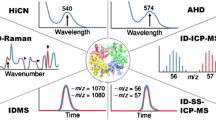Abstract
We present two different methods for determining levels of glutathione in complex biological samples and plasma. The DTNB/GR enzyme recycling method is sensitive and requires no specialized equipment. The HPLC method is particularly useful for situations in which sample amounts are limited. Detailed instructions for performing each method as well as the advantages and disadvantages of each are discussed in this chapter.
Access this chapter
Tax calculation will be finalised at checkout
Purchases are for personal use only
Similar content being viewed by others
References
Yam J, Frank L, Roberts RJ (1978) Age-related development of pulmonary antioxidant enzymes in the rat. Proc Soc Exp Biol Med 157:293–296
Frank L, Sosenko IR (1987) Prenatal development of lung antioxidant enzymes in four species. J Pediatr 110:106–110
Frank L, Sosenko IR (1987) Development of lung antioxidant enzyme system in late gestation: possible implications for the prematurely born infant. J Pediatr 110:9–14
Franklin CC, Backos DS, Mohar I, White CC, Forman HJ, Kavanagh TJ (2009) Structure, function, and post-translational regulation of the catalytic and modifier subunits of glutamate cysteine ligase. Mol Aspects Med 30:86–98
Dalton TP, Dieter MZ, Yang Y, Shertzer HG, Nebert DW (2000) Knockout of the mouse glutamate cysteine ligase catalytic subunit (Gclc) gene: embryonic lethal when homozygous, and proposed model for moderate glutathione deficiency when heterozygous. Biochem Biophys Res Commun 279:324–329
Dalton TP, Chen Y, Schneider SN, Nebert DW, Shertzer HG (2004) Genetically altered mice to evaluate glutathione homeostasis in health and disease. Free Radic Biol Med 37:1511–1526
Tietze F (1969) Enzymic method for quantitative determination of nanogram amounts of total and oxidized glutathione: applications to mammalian blood and other tissues. Anal Biochem 27:502–522
Adams JD Jr, Lauterburg BH, Mitchell JR (1983) Plasma glutathione and glutathione disulfide in the rat: regulation and response to oxidative stress. J Pharmacol Exp Ther 227:749–754
Smith CV, Hansen TN, Martin NE, McMicken HW, Elliott SJ (1993) Oxidant stress responses in premature infants during exposure to hyperoxia. Pediatr Res 34:360–365
Reed DJ, Babson JR, Beatty PW, Brodie AE, Ellis WW, Potter DW (1980) High-performance liquid chromatography analysis of nanomole levels of glutathione, glutathione disulfide, and related thiols and disulfides. Anal Biochem 106:55–62
Martin J, White IN (1991) Fluorimetric determination of oxidised and reduced glutathione in cells and tissues by high-performance liquid chromatography following derivatization with dansyl chloride. J Chromatogr 568:219–225
Jones DP, Carlson JL, Samiec PS, Sternberg P Jr, Mody VC Jr, Reed RL, Brown LA (1998) Glutathione measurement in human plasma. Evaluation of sample collection, storage and derivatization conditions for analysis of dansyl derivatives by HPLC. Clin Chim Acta 275:175–184
Rogers LK, Leinweber BL, Smith CV (2006) Detection of reversible protein thiol modifications in tissues. Anal Biochem 358:171–184
Santori G, Domenicotti C, Bellocchio A, Pronzato MA, Marinari UM, Cottalasso D (1997) Different efficacy of iodoacetic acid and N-ethylmaleimide in high-performance liquid chromatographic measurement of liver glutathione. J Chromatogr B: Biomed Sci Appl 695:427–433
Acknowledgments
The authors would like to thank Kathryn Heyob for her assistance in the preparation of this chapter. This work was supported by 5K08HL093365-02 (T.E.T.).
Author information
Authors and Affiliations
Corresponding author
Editor information
Editors and Affiliations
Rights and permissions
Copyright information
© 2012 Springer Science+Business Media, LLC
About this protocol
Cite this protocol
Tipple, T.E., Rogers, L.K. (2012). Methods for the Determination of Plasma or Tissue Glutathione Levels. In: Harris, C., Hansen, J. (eds) Developmental Toxicology. Methods in Molecular Biology, vol 889. Humana Press, Totowa, NJ. https://doi.org/10.1007/978-1-61779-867-2_20
Download citation
DOI: https://doi.org/10.1007/978-1-61779-867-2_20
Published:
Publisher Name: Humana Press, Totowa, NJ
Print ISBN: 978-1-61779-866-5
Online ISBN: 978-1-61779-867-2
eBook Packages: Springer Protocols




